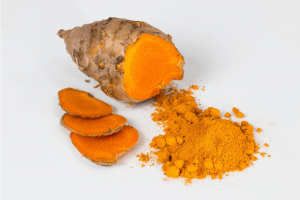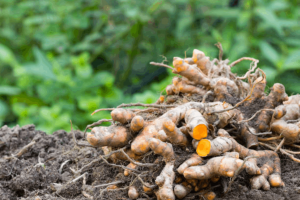How to Grow Turmeric from Seed to Harvest
Telangana ranks first in the country in turmeric cultivation area and yield. It is cultivated in about 68 thousand hectares and produces more than 4.2 lakh tons. Especially in Karimnagar, Nizamabad, Warangal, Adilabad, Rangareddy, districts. Turmeric is widely used for color, flavor and smell in food, in the preparation of medicines, as a perfume, in skin cosmetics, in the preparation of ointments, and in the dye industry.

Weather:
Turmeric is a tropical crop. A hot humid climate is favorable. Can be grown in any well watered area with a typical rainfall of around 1000-2000 mm. Rain dependent areas are suitable for turmeric cultivation.
The turmeric crop is shade tolerant and grows well. So it can be grown as an intercrop in fruit farm and coconut plantations. Shade crops of maize or castor can be intercropped.
Soils:
It can be grown in all types of soils from well-drained clay soils to alluvial soils. Well-drained and strong soils are best for growing turmeric. Alluvial lands, salt and alkaline lands, rocky lands and sandy soils are not suitable for turmeric cultivation.
Varieties:
Turmeric can be divided into three types depending on the harvesting season.
Short duration varieties:
Harvesting period is approximately 6-7 months. Eg : Kasturi, Suvarna, Suguna (PCT-13), Sudarshana (PCT-14).
Midterm varieties:
Harvesting period is approximately 7-8 months. Ex: Kesari (CLI 317), Krishna, Rashmi, Roma, Rajapuri, Alleppey.
Long term varieties:
Harvesting period is 9-10 months. Eg: Maidukuru, Tekur Peta, Duggirala, Armoru are important.
Planting time:
Short term varieties can be sown in the last week of May, midterm varieties in the first half of June and long term varieties in the second half of June.
Seed Per Acre:
Seed rate: 800 kg to 1000 kg of seed is required for planting in an acre area.
Harvesting: 7-9 months
Yield: 15,000 kg of yellow green horns per acre.
Turmeric Seed Turmeric Selection in Pro Trays:
Strong healthy seeds should be selected from a pest free crop. Mother and baby branches can also be used as seed. During this selection, damaged, sprouted and rotten yellow nodes should be removed. Seeding rate can be reduced by one-node or two-node branching. In this way the branches can be cut and grown in protrays for a month and then planted in the main field. This method can reduce seed dosage by 30 to 40%.
Planting:
The field selected for planting turmeric should be plowed 6-8 times to make it soft. If possible, 10 tones of cattle manure per acre should be mixed with 200 to 300 kg of neem flour in the last stage.
Turmeric can be planted in three ways.
- 20 cm height plants should be planted with a distance of 30 cm between the rows and 15 cm between the nodes. Practicing this method in black soils or clayey soils can protect the horns from the nodes.
- In the second method, 45-60 cm pits can be planted and 20 cm pits can be planted at the top of the pit slope. This method can also protect the horns from nodes in heavy soils.
- In the third method, make a furrow at a distance of 30 cm and plant the horns at a distance of 15 cm. This method can be practiced in paddy soils. Sewerage facility must be provided. Otherwise there is more chance of nodes.
Intercropping:
Two rows of turmeric and one row of maize or 10 rows of turmeric and one row of castor can be intercropped.
Similarly, cultivation of turmeric as an intercrop in coconut and mango plantations can generate additional income. When cultivated in this way, the recommended fertilizers for any crop should be applied at the specified time.
Water Management:
Water should be given at the right time as per requirement. Too much water or water logging can cause root rot. Water requirement is high especially when the nodes are ripening. In heavy soils up to 20 and in light soils up to 40 taps should be given.
Fertigation in Turmeric:
“Fertigation” is the application of water-soluble chemical fertilizers to the plants in the correct amount along with the cultivation water. In this method, the water and fertilizers are given in sufficient quantity to the plant at the same time, the nutrients are supplied directly to the plant roots.
Normally, chemical fertilizers containing nitrogen, phosphorus and potash are spread If applied to the soil, 40:20:50 percent of the nutrients will seep into the inner layers of the soil, some will be mixed in the air. If the same nutrients are provided in the form of fertigation, the utilization efficiency of nitrogen, phosphorus and potash will increase. That is, the fertilizers will be used effectively. Water-soluble chemical fertilizers are fed into the water in a drip system through a fertilizer tubes, which directly reach the plant’s root zone and are utilized.
Uses of Fertigation in Turmeric:
- Improved nutrient utilization
- Reduces loss of nutrients by infiltration into the soil layers.
- Controls the increase of salinity in the soil.
- Saves time, effort and energy
- Hardening of the soil does not occur
- No air pollution
- The cost of applying fertilizers is about a third of the normal method.
Higher yields with fertigation:
Fertigation results in higher yields as well as better fertilization compared to conventional methods. Therefore, if these modern methods are adopted and drip irrigation is practiced, precious water and fertilizers will be saved. If the fertilizer is determined for the crops based on the soil fertility and given to the plants through drip water without spreading it, the chemical fertilizers will be softened by half. Roots also rot. Bad smell comes from these rotten tubers and branches. Infested horns turn from orange to brown in color.
Harvesting:
Turmeric is harvested in the months of December-March depending on the variety planted. Maturity is indicated by the wilting of the leaves and plants. Water should be given two days before harvesting. The leaves should be cut from the stems.

Yield:
Yields about 15,000 kg of yellow green horns per acre.
Follow WalPencil to get to know cultivation tips for other vegetable crops like Onion, Beetroot, Radish , Garlic etc.
